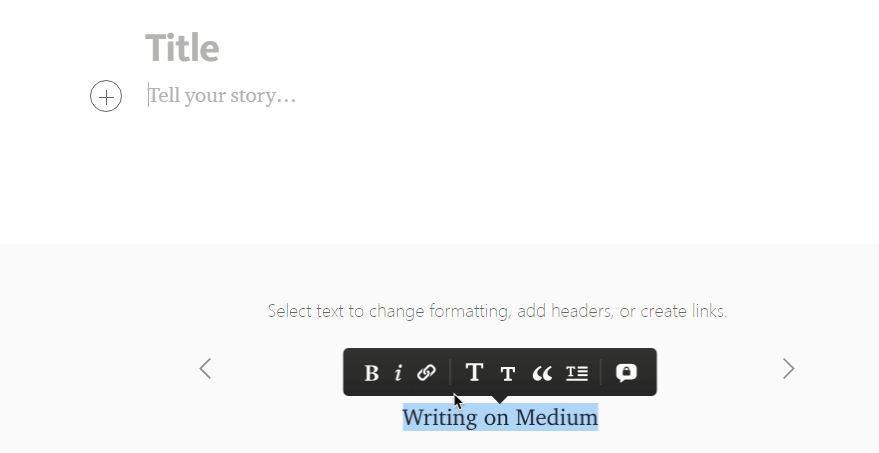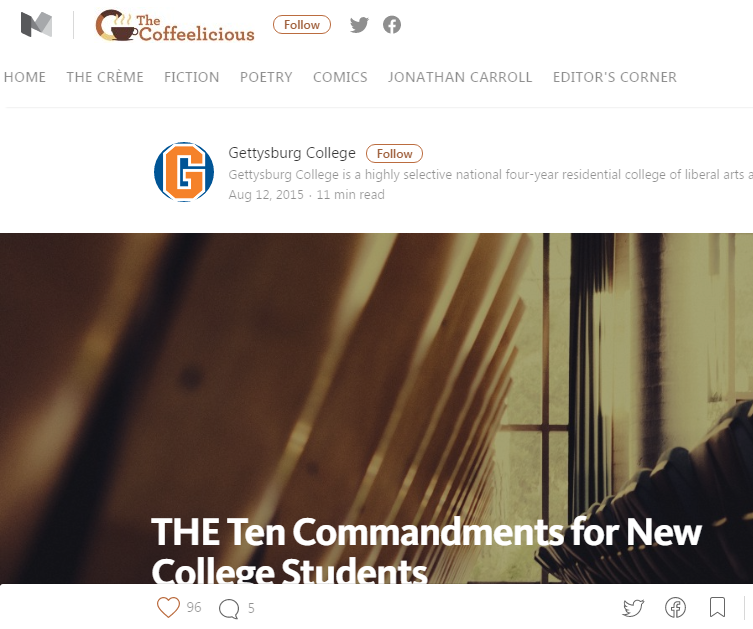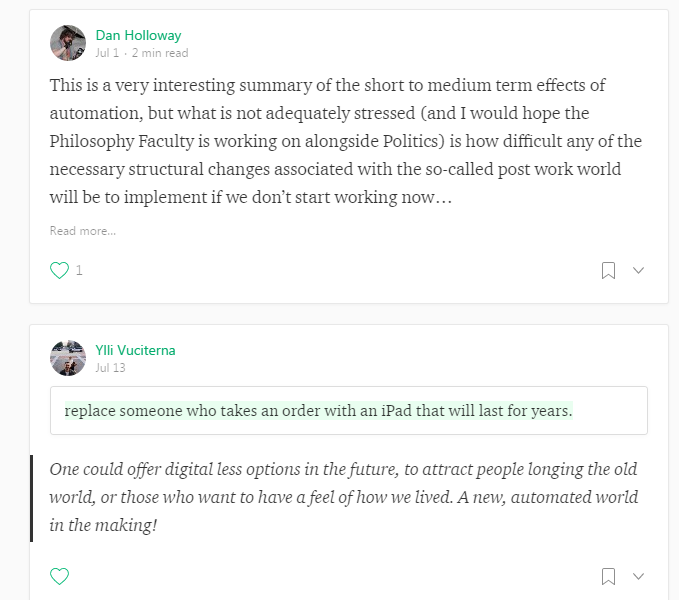
It’s been called the ‘YouTube of blogging,’ drawn comparisons to Reddit as a viral engine, and was created by two of the founders of Twitter. It’s estimated to attract somewhere between 15 and 20 million unique monthly visitors, despite being just over three years old. It’s free, easy to use, and rewards quality over name value.
For many content marketers, Medium, a long-form blogging platform launched in 2012, represents the next great hope, a powerful tool to help them cut through the noise of today’s crowded digital marketplace and increase their exposure and engagement with their target audience. But does it justify the hype? And what kind of opportunities does it offer for schools?
Read on to find out more about this exciting newcomer to the online sphere, and how your school can utilise its enormous potential.
What is Medium? An Intro for Student Recruitment Professionals
Medium was founded in 2012 by Evan Williams and Biz Stone, who had previously been involved in founding both Twitter and Blogger. The site’s aim is to present readers with content that will interest them, with an emphasis on quality over other factors which traditionally influence online visibility, such as site authority, SEO, and post quantity. In the Medium team’s own words, “Medium is a place where the measure of success isn’t views, but viewpoints. Where the quality of the idea matters, not the author’s qualifications.”
The site’s emphasis on long-form intellectual posts over the shorter, snappier content favoured by other platforms helped it quickly gain a cult following, with writers of all stripes using the site to gain exposure and build their followings.
Medium itself has been developing in its own content for the site since 2013, paying a small handful of writers on a freelance basis, and partnering with big names to produce premium content sites within Medium itself, such as Bill Simmon’s The Ringer and The Cauldron, a sports publication produced in collaboration with Sports Illustrated.
As its popularity has grown, the company has also begun to attract larger publishers, such as the Washington Post and The New Yorker, as well as brands and businesses, and now offers specialised services for both. Organisations in certain fields, such as Free Code Camp, a non-profit which offers free coding training, have even found the platform so useful at building engagement that they have abandoned their onsite blog altogether.
How Your School Can Set Up a Medium Account
Medium’s publishing platform employs a simple, easy-to-use ‘what you see is what you get’ editor that allows content creators to easily add headlines, images, and video:

The resulting posts are pristine and simple, with plenty of white space and room for customisation. Each post contains an estimated reading time in the sub-headline, and social sharing buttons for both Facebook and Twitter at the foot of the article.
Example: This post from Bentley University is a good example of a how a typical Medium page is laid out. You’ll notice in the left hand corner that Medium have judged the article as a ‘5 minute read.’

What really makes Medium’s platform special, however, is how users interact with content. Any time a reader clicks the heart icon, which is similar to Facebook’s like button, that story is automatically shared in the reading lists and email digests of that user’s followers. For schools, this means dramatically increasing the potential reach and visibility of your posts among prospective students’ peers.
Example: This post from Gettysburg College, which was published in Medium’s The Coffeelicous publication, attracted 96 recommendations. From that base, the school’s Head of Communications and Marketing Paul Redfern said the post amassed over 8,400 organic views.

Reader’s comments, known as responses, have also been supercharged to maximise user experience and shareability. Each Response is its own unique Medium page, and users can attach tags, comments and even recommend them as standalone stories. Your audience can respond at the end of the article or highlight any part of the text and respond specifically to that section. They also have the option of sending private notes to the author. This creates a whole new world of engagement possibilities for your digital student recruitment content.
Example: Below is an excerpt of some of the responses to an article by Oxford University News entitled “The Future of Work.” Notice that the second comment is a response to a specific sentence in the piece that the reader has highlighted.

Readers can also simply highlight any part of an article they feel is interesting and striking, and popular highlights are shared on user’s feeds every day. They also show up when new readers access your story, hopefully making it more scannable and directing them to its most important parts. The feature is incredibly popular and widely used on the platform, meaning that making sure your writing is striking and quotable is a must for schools hoping to maximise Medium’s potential.
Publisher or Writer? Which is Better for Schools?
There are two ways to set your school’s account up on Medium. You can simply set up a single account as a writer, or create your own Medium publication. The latter is probably more attractive to schools for a number of reasons. Firstly, your school will get its own won custom domain name on the site, and can also tailor the page layout as you see fit, incorporating your own logo, background images and navigation menu. Secondly, having your own publication means you can have a wider range of different writers contributing. Schools can publish articles from well-known faculty members, feature contributions from different departments, and even invite students to share stories on their publication, making it more engaging and likely to capture the attention of the Medium audience.
Example: Santa Clara University’s Medium publication features contributions from official university channels, faculty, and students.


But while this approach has its advantages, it could be argued that schools who enter the Medium fray as publishers rather than writers are failing to utilise the potential of the site as a viral engine. Medium is full of a wide range of publications with dedicated, highly educated fanbases, and schools who post articles as writers have the freedom to contact these established publications and contribute to them, potentially finding a much wider audience.
Example: Gettysburg College frequently contribute to a number of different publications. The post below was featured in Student Voices, a publication which collects students’ stories from a variety of contributors, and the perfect choice for a school using Medium to gain exposure.

With the platform is still in its early days, it’s difficult to say which approach is best for gaining traction, and the schools currently using Medium are fairly evenly split between publishers and individual account holders. It may an idea to maintain your own publication, but periodically contribute posts to others to increase your exposure, effectively giving you the best of both worlds.
The Best Thing About Using Medium for Student Recruitment Content? Analytics
Another huge advantage Medium offers for schools is a detailed analytics dashboard. Under the Stats page, both individual writers and publishers can view the total time users have spent reading on all their stories over the last 30 days:

You can also view previous months by clicking a simple link, and the screen also includes a graph of stats from your individual stories. Medium offers four extremely useful metrics for measuring the reach of individual stories:
- Views- The number of users who have clicked on your post.
- Reads- An estimate of how many users have read the post all the way through, based on the estimated reading time Medium has assigned it.
- Read Ratio- The percentage of users who read the story in full after clicking on it.
- Recommends- The amount of recommends a story has received from Medium users.
These values offer incredible opportunities to drive improvements in your content strategy for student recruitment. Armed with an estimate of how many prospective students are actually reading your content all the way through, you can get a sense of what kind of content they really find engaging. You might find that your best performing posts use plenty of visuals, address topical subject matter, or are just written particularly well, and seek to replicate those qualities in future posts.
Being able to compare your amount of Recommends to your Views and Reads is also quite useful in estimating the ROI you are getting from your Medium content: You can see how many views each recommend is worth, as well as how many fully read the story, which may indicate a seriously interested lead. This will help you refine and target your content more effectively.
In addition the these values, Medium also displays a Story Movement Graph for each post, which will show you when your article is being viewed and help you estimate the shelf life of your content. Even more importantly, clicking on the ‘Referrers’ tab will allow you to view a complete list of URLs and other services which sent traffic towards your story:

Schools that opt to set up their own custom domain publication on Medium also have the option of adding their Google Analytics ID to the site by filling out a simple form. However, it should be noted that there currently some limitations to the site’s GA integration, and your reporting will not track users who access your posts through the Medium app, or through RSS or Instant Articles.
Student Recruitment Content Strategies for Medium
At its most basic level, the principles behind creating successful content for Medium aren’t much different from the best practices you should already be employing in your higher education content marketing. Strategic keyword integration, relevant links back to your website, and other common SEO elements can all be used to good effect on the site, with calls to action carrying particular importance in turning casual readers of your posts on the site into genuine leads.
Example: The University of Northampton does a great job of creating strategically targeted posts which prospective students casually browsing Medium will come across.

This article, from a student blogger, which highlights the social aspect of university life, ends on a great CTA which encourages readers to visit the school’s site:

Where Medium differs from other digital channels is the type of content that gets noticed. The site, at least among its early adopters, is seen as something of an antidote to the bite-sized, lighter posts which tend do well on platforms like Facebook, Twitter, and Tumblr. Medium readers come to the site to read, and favour long-form articles with real substance that demonstrate thought leadership.
With that in mind, it might make sense to consider using the site as a place to amplify and share your more education-focused content which might not be suited to other digital channels, such as news on research and other academic topics. Having said that, timeliness is also crucial in getting your post to spread through Medium, so focusing on current events is also a good strategy.
Example: Boston University’s page takes a very research-oriented approach to the content it develops for Medium, often inviting their faculty to contribute to the site, but also tackles subject matter which is interesting and relevant for casual readers.


If you are importing content from your website to Medium or cross-posting on both at the same time, it’s important to use Medium’s official migration and import tools and WordPress plugin, rather than simply copying and pasting the text. These tools will automatically add your own website as the canonical link for the Medium version of the post, helping you to avoid any SEO penalties for duplicate content.
Once you have published content on Medium, push notifications will sent to all of your followers, and the article will also appear in Medium’s daily digest emails. However, you can also amplify the reach of your posts by sharing them on other social media sites like Facebook and Linkedin. Because of the site’s links to Twitter, any content you post will automatically be shared among your Twitter followers, provided you sign in using your official school account. In addition, Medium offers a paid promotion service for branded stories, with payments calculated using the site’s Total Time Read metric.
Medium’s Role in Your Future Higher Education Content Marketing Strategy
While Medium continues to grow all the time, it’s worth noting that the platform is still very much developing. In essence, it still functions very much like a start-up, and the company are constantly tweaking the site and introducing new features to make it more appealing. In addition, the company’s revenue model isn’t exactly set in stone yet. The site only introduced promoted stories and a paid subscription option for publishers earlier this year, and still features no other advertisements, although this could change as time goes on. Schools wishing to get the most out of the platform may need to work hard to stay up to date with developments.
In addition, while many publishers and writers have taken the leap to using Medium as the sole platform for their blog content, the site’s long-term viability is unproven, and schools should be cautious about devoting too much attention to it at the expense of other digital channels.
Nonetheless, it does have the potential to play an important role in a wider content marketing strategy, helping you to reach a highly coveted ,well-educated demographic of readers you might not otherwise be able to access. And once you establish your presence on the site, the detailed analytics Medium offers for your posts will give you a good sense of what kind of ROI the platform is delivering for your school, and help you determine just how worthwhile it is.
Has your school tried Medium Yet? Leave a comment below and tell us about your experiences on the site!






